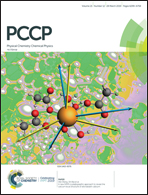Optical properties of aluminum intercalated magnesium nanoparticle square array: a computational study†
Abstract
Magnesium nanostructures have recently emerged as a vivid and amazing plasmonic material. Using computationally efficient time-dependent density-functional theory calculations, we investigate the optical response of a highly ordered magnesium nanoparticle array with interparticle gap distances varying in the range of 0.5 nm to 2.0 nm. We reveal that depending on the interparticle gap distance (d), significant spectral modulations are possible. More specifically, for d = 1.0 nm, we have observed a huge optical field enhancement due to the interparticle plasmon coupling. In contrast, we obtained highly quenched spectra for d = 0.5 nm, 1.5 nm and 2.0 nm. While for d = 0.5 nm, strong electron tunnelling causes spectral reduction, whereas, for d = 1.5 nm and 2.0 nm, the nanoparticles are plasmonically decoupled to a large extent. Further, we study the impact of aluminum intercalation on the optical response, finding vivid spectral modulations. We believe that our findings will be helpful in the design of ultra-sensitive plasmonic devices based on magnesium nanoparticle arrays.



 Please wait while we load your content...
Please wait while we load your content...